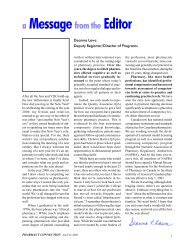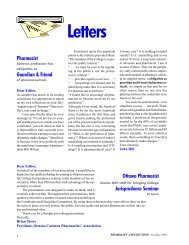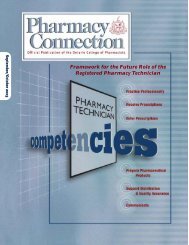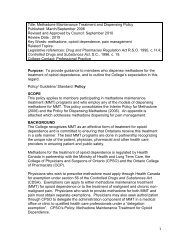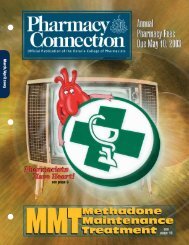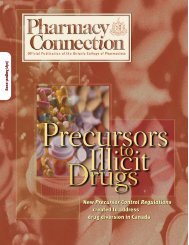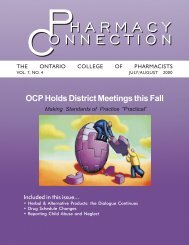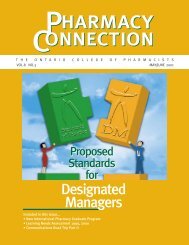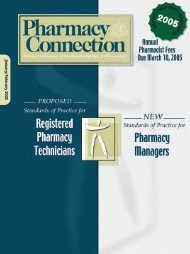Understand the Culture in Which You Practise Hyperthermia: Are ...
Understand the Culture in Which You Practise Hyperthermia: Are ...
Understand the Culture in Which You Practise Hyperthermia: Are ...
You also want an ePaper? Increase the reach of your titles
YUMPU automatically turns print PDFs into web optimized ePapers that Google loves.
• not understand<strong>in</strong>g wea<strong>the</strong>r conditions -- older persons at risk<br />
should stay <strong>in</strong>doors on especially hot days.<br />
The use of certa<strong>in</strong> prescription medications can also <strong>in</strong>crease<br />
an <strong>in</strong>dividual’s risk of develop<strong>in</strong>g hyper<strong>the</strong>rmia. The<br />
drugs implicated <strong>in</strong> cases of hyper<strong>the</strong>rmia decrease <strong>the</strong> body’s<br />
ability to dissipate heat, and also may impair a person’s perception<br />
of <strong>in</strong>creased body temperature (which results <strong>in</strong> failure<br />
to seek relief from environmental factors contribut<strong>in</strong>g to<br />
<strong>the</strong> hyper<strong>the</strong>rmia). The medications listed <strong>in</strong> <strong>the</strong> chart below<br />
have been shown to decrease <strong>the</strong> body’s ability to regulate <strong>in</strong>ternal<br />
temperature.<br />
In light of <strong>the</strong> coroner’s f<strong>in</strong>d<strong>in</strong>gs, pharmacists should be<br />
m<strong>in</strong>dful of <strong>the</strong> standards of practice for educat<strong>in</strong>g patients<br />
on <strong>the</strong>ir medications. As side effect profiles change with cont<strong>in</strong>ued<br />
use of a medication <strong>in</strong> a cl<strong>in</strong>ical sett<strong>in</strong>g, it is important for<br />
pharmacy managers to be aware that Standards for Pharmacy<br />
Managers states that <strong>the</strong> manager shall ensure that all new,<br />
professionally relevant <strong>in</strong>formation directed to <strong>the</strong> pharmacy<br />
is immediately available to <strong>the</strong> staff pharmacists. Additionally,<br />
staff pharmacists are rem<strong>in</strong>ded that Standard 3 requires that<br />
<strong>the</strong> pharmacist identify, evaluate, <strong>in</strong>terpret, and provide appropriate<br />
drug and pharmacy practice <strong>in</strong>formation to achieve<br />
safe and effective patient care.<br />
With this <strong>in</strong> m<strong>in</strong>d, and particularly <strong>in</strong> <strong>the</strong> warmer summer<br />
months, additional patient counsell<strong>in</strong>g should <strong>in</strong>clude general<br />
advice regard<strong>in</strong>g prevention and treatment of heat- related<br />
symptoms:<br />
• Know <strong>the</strong> signs and symptoms of heat-related illnesses.<br />
• Block out direct sun or o<strong>the</strong>r heat sources.<br />
• Use cool<strong>in</strong>g fans or air condition<strong>in</strong>g; rest regularly.<br />
• Dr<strong>in</strong>k lots of water: about one cup every 15 m<strong>in</strong>utes.<br />
• Wear lightweight, light-coloured, loose-fitt<strong>in</strong>g clo<strong>the</strong>s.<br />
• Avoid alcohol, caffe<strong>in</strong>ated dr<strong>in</strong>ks, or heavy meals.<br />
References:<br />
• eTherapeutics (onl<strong>in</strong>e subscription)<br />
• Health Encyclopedia – Diseases and Conditions:<br />
www.healthscout.com<br />
• US Department of Labor (Occupational Safety and Health<br />
Adm<strong>in</strong>istration) OSHA ‘Quick Card’ – Heat Stress:<br />
www.osha.gov<br />
• Medl<strong>in</strong>e Plus:<br />
www.nlm.nih.gov/medl<strong>in</strong>eplus/ency/article000056.htm<br />
• www.connpost.com/women/ci_9890519<br />
Antichol<strong>in</strong>ergic drugs<br />
benztrop<strong>in</strong>e, biperiden,<br />
ethopropaz<strong>in</strong>e, procyclid<strong>in</strong>e<br />
trihexyphenidyl<br />
Impair <strong>the</strong> body’s ability to lower its<br />
temperature by perspir<strong>in</strong>g.<br />
Phenothiaz<strong>in</strong>es<br />
chlorpromaz<strong>in</strong>e, perphenaz<strong>in</strong>e,<br />
thioridaz<strong>in</strong>e, trifluoperaz<strong>in</strong>e,<br />
fluphenaz<strong>in</strong>e<br />
Neuroleptic malignant syndrome (very rare,<br />
but potentially fatal, reaction)<br />
Butyrophenones<br />
Haloperidol<br />
Drug-<strong>in</strong>duced hyper<strong>the</strong>rmia<br />
Tricyclic antidepressants<br />
amitriptyl<strong>in</strong>e, imipram<strong>in</strong>e,<br />
trimipram<strong>in</strong>e, clomipram<strong>in</strong>e,<br />
desipram<strong>in</strong>e, nortriptyl<strong>in</strong>e<br />
Interfere with heat dissipation mechanisms by<br />
<strong>in</strong>creas<strong>in</strong>g body temperature and exert<strong>in</strong>g an<br />
antichol<strong>in</strong>ergic effect.<br />
Antihistam<strong>in</strong>es, benzodiazep<strong>in</strong>es,<br />
alpha-adrenergics,<br />
beta blockers, neuroleptics,<br />
diuretics<br />
Increase <strong>the</strong> risk of <strong>in</strong>ability to produce<br />
sufficient perspiration for body cool<strong>in</strong>g.<br />
pharmacyconnection • July/August 2009<br />
19



